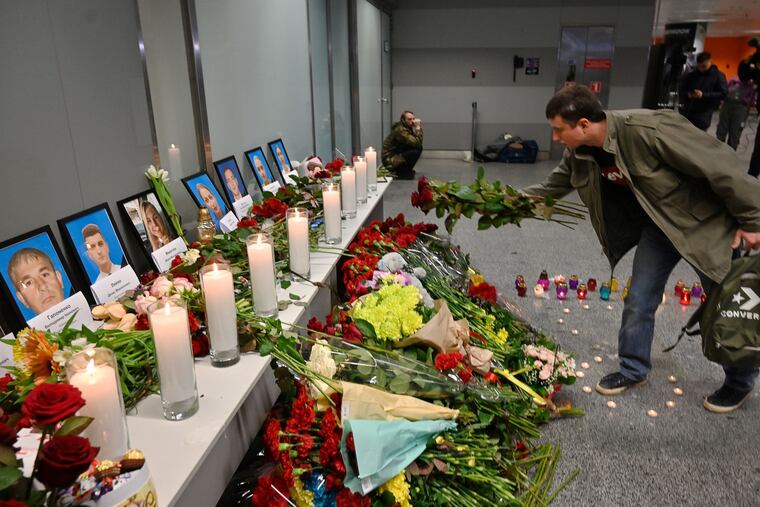Phase Two of the U.S.-Iran conflict will take place in Iraq | Trudy Rubin
This is a moment — in the wake of the mild Iranian response to Soleimani's killing — when everyone needs to take a deep breath.

This is a moment — in the wake of the Soleimani killing and the mild Iranian response — when everyone needs to take a deep breath.
Iranian officials are clearly shocked and debating their options. They will have to factor in the fallout if, as evidence indicates, Iran mistakenly downed a Ukrainian airliner.
Whether or not it was necessary or wise to kill Gen. Qassem Soleimani, his death won’t produce World War III. The Iranian response will be asymmetric and occur over time.
Tehran’s goal is to drive the United States out of the Mideast, using proxy Shiite militias that Soleimani fostered around the region. The immediate focus of Iranian efforts is Baghdad.
“What we have is a pause, not victory,” says veteran U.S. diplomat and former ambassador to Iraq Ryan Crocker. “For the next step, watch Iraq.”
» READ MORE: Trump and Iran have paused, but the confrontation isn't over | Trudy Rubin
So let us watch. The 2003 invasion opened the door to Iranian influence in Iraq after the U.S. overthrew the Sunni dictator Saddam Hussein.
Iran shares a 900-mile border with Iraq, in which a majority of Arabs are Shiite, as are most Persians.
The George W. Bush administration naively believed all Shiite Iraqis would welcome the U.S. with open arms because Saddam had oppressed them. But when I traveled to the holiest Shiite shrine city, Najaf in southern Iraq, in May 2003, religious leaders told me the Americans owed them big time. The first President Bush, they bitterly complained, had called on them to rise against Saddam during the 1991 Gulf War, then let Saddam slaughter them.
“The Americans should stabilize Iraq and leave,” senior clerics said.
The Americans did neither, instead helping to create a sectarian political system, with Shiite, Sunni, and Kurdish political parties that corruptly divide oil spoils and fail to meet the country’s basic needs.
Soleimani helped Tehran cement control over key Shiite political movements. After ISIS swept into northern Iraq in 2014, the Iranian general also shaped Shiite militias into a powerful fighting force against it. Tehran still hopes to subsume the regular Iraqi army under the control of Shiite militias loyal to Iran.
In reaction to Soleimani’s death, pro-Iranian parties in parliament voted for the 5,000 or so remaining U.S. troops to leave. Prime Minister Adil Abdul-Mahdi has asked to discuss steps for their withdrawal. But it’s not at all clear that most Iraqis want them out.
“The parliament’s decision was nonbinding,” I was told by phone from Erbil, in Iraqi Kurdistan, by Hoshyar Zebari, Iraq’s longest-serving foreign minister (2003-14) and a leader in its Kurdish region. “The current Iraqi caretaker government doesn’t have the legitimacy to take this decision.”
Equally important, Kurdish and Sunni parties didn’t vote, nor are all Shia parliamentarians on board. “Any such move has to be done with a national consensus, which isn’t there,” said Zebari.
To understand why Iraqis are divided on this, one need only look at the massive street protests in Baghdad and elsewhere, before Soleimani’s death, against Iranian domination, and corrupt sectarian politics.
About 450 of these young demonstrators have been killed by Shiite militiamen, probably on Soleimani’s orders. This is the most powerful movement for change since the U.S. invaded Iraq.
True, some demonstrators also spoke of the need for all foreign forces to leave, including Americans. “But,” said Zebari, “this is not really the public sentiment on the street.” And if U.S. troops leave, Iranian proxy militias will have an even freer hand to crush the protests.
“The key message,” Zebari continued, “is that the U.S. should not leave. If they evacuate, there would be a vacuum, chaos, a failed state. It would expose all U.S. allies to the threat of terrorism, and regional interference.”
In other words, Iranian influence would grow around the region despite Soleimani’s death.
Morever, if U.S. forces exit Iraq, the last American troops would also have to quit northern Syria, since they are supplied from Iraq. Iranian influence over Syria, and Hezbollah in Lebanon, would be cemented, to Israel’s detriment.
» READ MORE: After Soleimani's death, how does this war end? | Trudy Rubin
If the U.S. gets nervous in coming days that Iran’s proxies may attack its forces in Iraq, Zebari has a solution. He says, “They could relocate to Kurdistan if they feel threatened.
“We welcome them,” he adds.
Right now, State Department officials are resisting any talk of a pullout. Yet on Wednesday, President Donald Trump talked of expanding a NATO role in Iraq (useless without a strong U.S. presence).
Some see the president’s talk of NATO as a hint that he wants an early U.S. exit. At the same time, in a true Trump contradiction, his threats to sanction Iraq if the government asks Americans to leave -- along with insulting, public State Department rebuffs of the prime minister’s request -- make it harder for any Iraqi official to defend a continued U.S. presence.
Bottom line: It is time for serious, behind-the-scenes talks in Baghdad on how to keep U.S. troops in Iraq for now, despite Trump’s temptation to pull them before November elections. To remove them now would be as powerful a tribute to Soleimani as the ayatollahs gave him in Tehran.